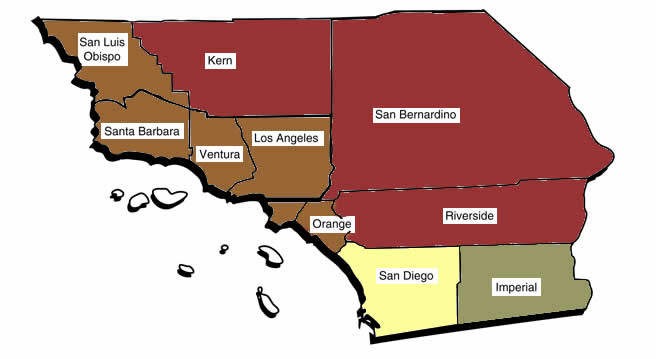
Apparently, immigration officials haven’t read recent reports about how to fix our broken immigration system.
Perhaps they just don’t care.
But whatever their rationale, their recently-announced plan to open a new immigration detention center in Southern California is misguided.
To be located in Adelanto, a small city in San Bernardino County, the detention facility will be run by a private company.
It’s estimated the new immigration jail will generate $21 million per year at 75% occupancy. That’s a lot of money, especially in these tough economic times.
In my view, the deal raises questions anew about the connections between lobbyists for privately-run prisons and elected officials.
Given a limited immigration budget, the money should be used for a better purpose.
My idea?
Build a new immigration court in the Inland Empire.
Study after study, as discussed in The Immigration Court: In Search Of Efficiency, Justice, And Due Process, confirms the massive amount of recent incarcerations has become a main source of backlogs and inefficiencies at immigration court.
Simply stated, spending funds on a new court is a wiser investment than spending on a new jail.
A Day In The Life Of An Inland Empire Immigration Lawyer
As a Riverside and San Bernardino deportation defense lawyer, I have personal reasons for supporting the building of an immigration court in the Inland Empire. Many of my clients’ hearings are held in Los Angeles.

For clients living in Adelanto – as well as in nearby cities like Victorville, Banning, Beaumont, Colton, Moreno Valley, Perris, San Jacinto, and Hemet – the commute to Downtown Los Angeles is often an all-day affair. On a good day, it’s a 2 – 3 hour drive, each way.
Usually, if the hearing is set for the morning calendar, I leave Riverside by 4:00 a.m.
Besides the distance, there are two other reasons for this early morning departure.
First, as most Southern Californians likely appreciate, I prefer to avoid getting trapped in the Los Angeles morning rush hour traffic.
Second, and more significant, the immigration court in Los Angeles is the busiest immigration court in the country.
And it’s first come, first serve. The early bird attorneys have their cases heard first.
On some days, there may be 50 or more hearings assigned to a particular courtroom. If you’re not one of the first lawyers to arrive, you may have to wait several hours before the judge listens to your case.
And then there’s the ride back home.
The Need For A New Immigration Court In Southern California
Overcrowding, as noted above, at the Los Angeles immigration court is a big problem.
California has three major immigration courts. Los Angeles, San Francisco, and San Diego.
As immigration statistics for 2010 show, glaring disparities exist between the three courts:
- The Los Angeles immigration court has 31 judges and 43,408 pending cases. On the average, each judge has 1,400 cases. It takes 845 days to complete cases.
- The San Francisco immigration court has 18 judges and 15,159 pending cases. On the average, each judge has 842 cases. It takes 526 days to complete cases.
- The San Diego immigration court has 7 judges and 3,435 pending cases. On the average, each judge has 491 cases. It takes 349 days to complete cases.
The above statistics show even though the Los Angeles court has the most judges, each judge there is responsible for a significantly larger amount of cases than judges in San Francisco and San Diego. As can be expected, this causes the Los Angeles immigration court to experience the longest delays in moving cases from start to finish.
Being a San Bernardino immigration lawyer, the solution seems equally obvious.
Reduce the reach of the Los Angeles immigration court.
Presently, there are 11 counties in Southern California. All except Imperial County and San Diego County fall under the jurisdiction of the Los Angeles immigration court.
(Like San Diego, Imperial County has its own immigration court, located in the City of El Centro. Two judges are assigned full time to El Centro, with a caseload of 780 cases. Most of the cases involve detained immigrants facing fairly quick removal to their home countries based on felony criminal convictions.)
Southern California Counties By Population
A quick glance at the top ten populations of Southern California counties illustrates the problem confronting the Los Angeles immigration court.
In the list below, only San Diego County does not fall under Los Angeles’ purview. This means the Los Angeles immigration court is responsible for 9 of the largest 10 counties, with a combined population of 22,093,113.
- Los Angeles (10,441,080)
- San Diego (3,224,432)
- Orange (3,166,461)
- Riverside (2,139,535)
- San Bernardino (2,073,149)
- Santa Clara (1,880,876)
- Kern (844,713)
- Ventura (839.587)
- Santa Barbara (434,481)
- San Luis Obispo (273,231)
If an immigration court was built in San Bernardino, the new court’s jurisdiction could include Riverside County and Kern County, both of which are adjacent to San Bernardino County.
This would remove Southern California’s 4th, 5th, and 7th populations from the Los Angeles mix.
Combined, the three counties account for 5,052,271 residents. By building a new court to serve this population, the population under Los Angeles’ jurisdiction would be reduced by 22%.

Assuming the population count bears some resemblance to immigration cases, nearly 10,000 cases would be removed from the Los Angeles immigration court.
This would lighten the load of immigration judges in Los Angeles, which should, in turn, reduce the amount of time it takes to complete cases.
Sounds like a win-win situation to me. A win for the immigration court. A win for immigrants.
And much better than another publicly funded, privately run detention facility.
By Carlos Batara, Immigration Law, Policy, And Politics




